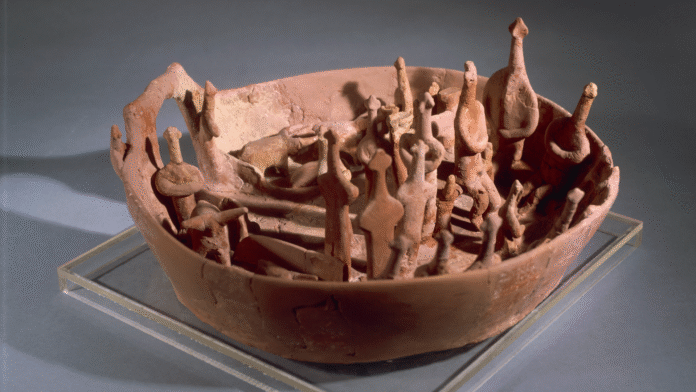Unveiling the Mysteries of the Vounous Bowl: A Glimpse into Bronze Age Rituals and Symbolism
Explore the intricate artistry and cultural significance of this ancient ceramic vessel from northern Cyprus, believed to depict sacred scenes and reflect a transformative era in society.
The Vounous Bowl: A Glimpse into Bronze Age Rituals in Cyprus
Location: Bellapais, Northern Cyprus
Date: Circa 2025 to 1850 B.C.
Artifact Type: Ceramic vessel with intricate figural scenes
The Vounous Bowl, a remarkable artifact unearthed from a Bronze Age tomb in northern Cyprus, continues to captivate scholars and archaeologists alike. Discovered during excavations at the Vounous-Bellapais site in the 1930s, this ceramic vessel is not only a testament to the artistry of its time but also a window into the complex social and religious practices of ancient Cypriots.
Discovery and Excavation
The Vounous Bowl was found among numerous tombs in a large prehistoric cemetery, where many graves had been previously looted. Despite this, archaeologists managed to recover a wealth of artifacts, including the Vounous Bowl, which had suffered significant damage over the centuries. The excavation, led by a team of archaeologists, revealed a rich tapestry of life in the Bronze Age, characterized by intricate ceramics and burial practices.
Description and Features
Measuring 14.6 inches (37 cm) in diameter and 3.1 inches (8 cm) tall, the Vounous Bowl is shallow with a flat base. Its most striking feature is the complex scene depicted within, which includes 18 human figures, four cows in pens, and various pieces of furniture. One side of the bowl features a rough, rectangular hole, interpreted as a doorway, suggesting a narrative or ritualistic significance.
The interior scene is rich with symbolism. Opposite the doorway, a structure resembling a shrine is depicted, characterized by three pillars linked by crossbars adorned with wavy lines. A kneeling figure in front of this structure adds to the scene’s spiritual undertones. Other figures are shown seated, some with arms crossed, while one figure appears to be adorned with a headdress, possibly indicating a position of authority.
Interpretations and Significance
Scholarly interpretations of the Vounous Bowl have varied, with many experts suggesting it served a ceremonial purpose. Louise Steel, an archaeologist at the University of Wales Trinity Saint David, posits that the bowl was likely a means of symbolic communication during a period of rapid social change. In her 2013 study, she emphasized that the bowl’s unique design and the use of modeled figures were rare for prehistoric Cypriot vessels, indicating its special significance.
Edgar Peltenburg, emeritus professor of archaeology at the University of Edinburgh, proposed in a 1994 study that the bowl encapsulates three distinct scenes: a pastoral scene with cows, a representation of male power through the figure with a headdress, and a depiction of the spiritual realm with kneeling figures. This triadic representation may reflect the emerging hierarchical social structures of the time.
Cultural Context
The Vounous Bowl was crafted during a transformative era in Cypriot history, marked by population growth and the evolution of communal rituals. Steel noted that the bowl was likely intended for display during significant ceremonial occasions, reinforcing its role in the funerary context. The intricate artistry and symbolic elements suggest that it was buried with an individual of high status, possibly as a means of honoring their memory and facilitating their journey into the afterlife.
Current Location
Today, the Vounous Bowl is housed in the Cyprus Museum, where it continues to be a focal point for research and public interest. Its intricate design and the mysteries surrounding its purpose contribute to ongoing discussions about the social and religious dynamics of Bronze Age Cyprus.
Conclusion
The Vounous Bowl stands as a remarkable artifact that encapsulates the complexities of ancient Cypriot society. Its detailed scenes offer insights into the rituals, beliefs, and social hierarchies of a civilization that thrived thousands of years ago. As research continues, the bowl remains a vital piece of the puzzle in understanding the rich tapestry of human history in the region.
